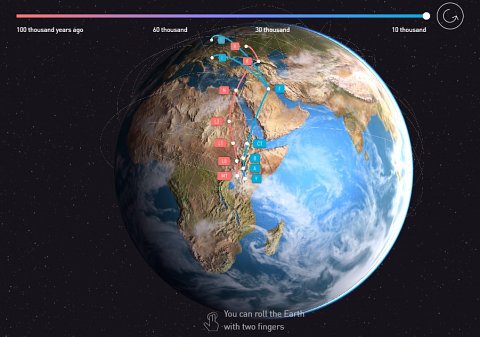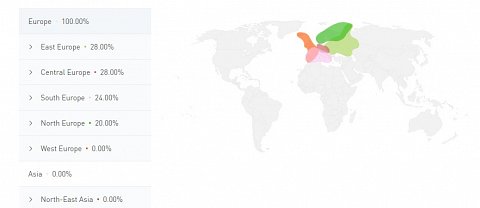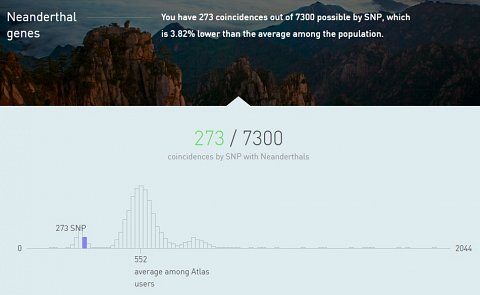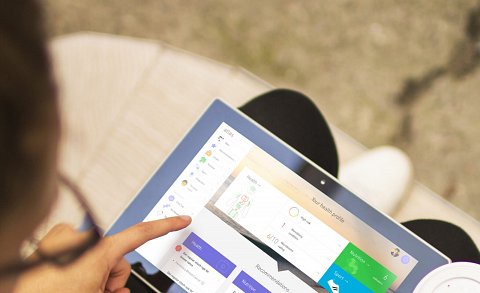-
Atlas DNA Test
review on 1 September 2018
by Craig Macpherson

At a Glance
Summary
I really enjoyed the various ancestry-related aspects of the Atlas DNA Test. The Ancestry Composition was a lot more specific than it first appeared and I loved the interactive globe that was used to introduce my haplogroup information. The trait results were unusual but interesting and I came away with not only knowledge about myself, but about topics I was unlikely to have come across otherwise.
At times, I was a bit confused by some of the terminology and was also surprised that my Ancestry Composition showed such a low British percentage, but overall it was easy to interpret my results and I received some valuable insights into my heritage. Taking into consideration the health information also provided in the test, I thought it was excellent value for money and would recommend it.
Full Review
Atlas Biomed is the genetic testing company behind the world’s first DNA and microbiome platform. Both types of tests offered by the company aim to help customers to alter the way they see their health, encouraging preventative rather than reactive solutions. It was founded earlier this year by Sergey Musienko and is based in London, UK. As well as health, the Atlas DNA Test provides insights into ancestry and personal traits, giving customers the chance to look back into their heritage as well as to the future, towards improving their health.
I was interested to see if the test would reveal any unknown traits or aspects of my ancestry, so took it to find out!
Please note that reviews for the health-related aspects of the test can be found here.
Product Expectations
I was able to find plenty of information about the test on the Atlas Biomed website. On the homepage I was greeted by the statement, “You can change” and invited to scroll down to see more about the tests. Here I was able to see images of both the ‘DNA Test’ and ‘Microbiome’ kits and bullet points with details about them. From these I learnt that the test would help me to explore my ancestry and find out more about my personal traits. It would provide health information, including details about my risk of developing or passing on diseases and the impact of my DNA on my eating and exercise habits.
There was a section dedicated to further details about the test, where I found out that 15 indicators would be used to look at ancestry and I’d receive an ethnicity estimate based on more than 200 populations. I’d also receive my maternal and paternal haplogroups and the ratio of Neanderthal genes in my genome.
The test would also look at 15 personal traits and although I couldn’t find a full list of which these would be, a few examples were given: pain sensitivity, early grey hair and whether I was likely to sneeze when suddenly exposed to sunlight.
A ‘How it works’ page explained the process of testing, which seemed pretty straightforward. This description was accompanied by images of the kit and its contents, as well as previews of each section of the results. It was great to be able to see, in so much detail, exactly what I’d receive before ordering.
Ordering Experience
To purchase the test, I clicked on one of the ‘Order now’ buttons and entered my name, address, email and phone number. I was happy to read that the kit was estimated to take only 2-3 days to arrive once I’d placed the order. However, when I realised that I had to pay a £9.99 shipping cost for this service, it didn’t seem so impressive.
Payment was processed through Stripe and I just had to input my card details. First though, I had to agree to the Terms & Conditions. From what I’d seen on the How it works page, I was already impressed with the privacy protection provided. They’d included the exact type of encryption and security that the company used and on the whole, the terms and conditions also seemed to offer good protection.
One point, however, that worried me a bit, was that the company had the right to use my genetic and self-reported data for research and development of products or services that I would be able to claim no compensation for. I was also a bit alarmed when I read that I should consult with a legal professional before sharing my genetic results with anyone, as they could be used against my interests. Although this seemed quite dramatic, I guessed that it was a sensible precaution to advise and appreciated that they had been open about the possible risks associated with testing.
I received the kit within the 2-3 days that had been estimated and was happy to see that it looked just like the one I’d seen on the website. Registration was straightforward and taking the saliva sample was simple. I was pleased to see that the shipping cost had included return postage, making it easy to send back to the lab.
The Results
I received an email informing me that my samples had reached the lab, and another once the results were ready about a month later, which was what the website had estimated.
The email prompted me to log in to the account I’d set up when registering the kit to access my results. I was initially shown an introductory ‘Dashboard’ page that provided a summary of my report. The top sections were all health-related, but I scrolled down the page to find the ‘Ancestry’ and ‘Personal Traits’ ones. These gave me a preview of my results, revealing my haplogroups, the fact that 100% of my DNA was European, and that I had 273 coincidences with Neanderthals. I could also see a few of the specific traits covered in the results.
Results Section: Haplogroups
I clicked through to the full Ancestry section first which started with an introduction and video at the top of the page. This showed me the migratory routes associated with my maternal and paternal haplogroups over the last 100,000 years on a globe (shown below). It was a great introduction to the results and I noticed that once the video had finished it became interactive, meaning I could spin it around to look more closely at the routes.

The globe showing my maternal and paternal migratory routes.
I was really impressed with the quality of this feature and was excited to see the rest of my results in more detail.
Further information about my haplogroups was included directly below this globe (shown below).

My Haplogroups results.
I found out that my paternal haplogroup (I1a1b) is the most common in Scandinavia and first appeared around 20,000 years ago. It was also cool to find out that this meant that I shared some (if very distant!) ancestry with Warren Buffet and Leo Tolstoy.
I saw that I could click on the haplogroup to read more about it. However, when I did I was shown a page that, in contrast to the results I’d come across so far, was made up of a large chunk of text and no images. Whilst this provided lots of interesting information, it was quite hard to read through and I didn’t end up taking much of it in.
My maternal haplogroup was K1a4a1e, which was about 25-40,000 years ago and was spread across a wider geographical area than my paternal one had been. Unfortunately, this result didn’t any famous people that also belonged to this group, but it was still interesting to read about it.
Results Section: Ancestry Composition
The next section I looked at was Ancestry Composition. Having already learnt that my DNA was 100% European, I was intrigued about where within the continent my ancestors had come from.
I was therefore pleased to see that it had been broken down, first into areas of Europe (e.g. North, South, Central etc.) and then into specific countries. I was surprised to read that more of my DNA was from Eastern and Central Europe than Northern Europe, even though my family and I are British. In fact, only 16% was attributed to the British Isles!
There was a map next to the results that showed the areas my DNA was associated with (shown below).

Some of my Ancestry Composition results and map.
This was quite helpful as a way of visualising my results, but was a bit too small to see enough detail and I couldn’t zoom in to specific areas.
Results Section: Neanderthal genes
The final section of my Ancestry results was Neanderthal genes. I didn’t really know much about Neanderthals so was pleased to find a comprehensive but easily understandable explanation. I read that although they weren’t our direct ancestors, we had inherited DNA from them as it was likely that they lived alongside our predecessors in Eurasia, before being driven out by them around 30,000 years ago.
I thought this was fascinating and was interested to learn that I had 273 out of the possible 7300 Neanderthal ‘coincidences by SNP’, which was apparently 3.82% less than the 552 average. My result is shown below.

My Neanderthal results.
I wasn’t quite sure what ‘coincidences by SNP’ meant, and unfortunately this wasn’t explained. However, I looked up ‘SNP’ and found out that it was the most common type of genetic variant, which made it a bit clearer.
Even without completely understanding the terminology, it was easy to work out that this meant I had less Neanderthal DNA than average and it was also made clear that I didn’t have any of the Neanderthal genetic variants associated with back hair or LDL Cholesterol.
Results Section: Personal Traits
The final section I looked as was Personal traits, which included 12 results, split into four categories: ‘Perception’, ‘Appearance’, ‘Body traits’ and ‘Brain’. Some of them are shown below.

My Perception traits.
All but two of my results were highlighted in purple, but I couldn’t work out why in this case. They were an unusual range of traits, including three that focused specifically on the structure of the iris of my eye. One of these was ‘Iris structure: contraction furrows’ which I had never even heard of.
Luckily, when I clicked to read more there was an explanation. According to my DNA, I’m more likely to have strong contraction furrows, which are the intermittent lines in the eye. I was fascinated to learn that these were caused by the movement of the pupil. Although I thought I knew what these were from the description, I used Google images to confirm that what I was imagining, as there weren’t any images included with the result.
Another result I was intrigued by was ‘Episodic memory’. I wasn’t aware that there were different types of memory, so was interested to learn that it can be semantic and episodic, the first of which is based on recalling facts and concepts and the second of which is based on personal experience. The result itself indicated that I would ‘display average indicators of episodic memory’, and provided information about the scientific link between my DNA and memory, including a description and link to a relevant study.
I was also impressed to see that the specific gene and variant that had been examined to get this result was also included, which I could click to find out more information about. When I did, I was reminded that I could download a full copy of my raw DNA data, which was a bonus. The information about the gene included which chromosome it was located on and which other genetic variants within it had been included in the test.
Summary
I really enjoyed the various ancestry-related aspects of the Atlas DNA Test. The Ancestry Composition was a lot more specific than it first appeared and I loved the interactive globe that was used to introduce my haplogroup information. The trait results were unusual but interesting and I came away with not only knowledge about myself, but about topics I was unlikely to have come across otherwise.
At times, I was a bit confused by some of the terminology and was also surprised that my Ancestry Composition showed such a low British percentage, but overall it was easy to interpret my results and I received some valuable insights into my heritage. Taking into consideration the health information also provided in the test, I thought it was excellent value for money and would recommend it.


